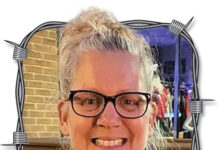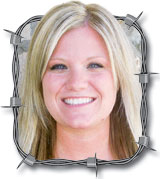Do you happen to belong to one of those families that has a problem with cattle? By a problem I mean, no matter how bad the market, the weather, the finances or the morale, you still keep raising cattle. Well, I belong to one of those families. I grew up to marry an Ozarks cowboy who also had a "problem" with cattle, and horses too. Fresh out of college, with shiny new animal science degrees, we still hadn't figured out the cattle dilemma. Our first year of raising cattle saddled us with five breech calvings and the resulting vet bills. I suppose being born into a lifestyle, with the optimism of youth, one recognizes dysfunction even less. Or perhaps it was because our children inherited the "problem," as third generation farmers from both sides of the family tree.
All this leads to the saga of the youngest sufferer of the cattle malady, Sara Hacker, my eight-year-old.
Sara has been showing cattle with her grandparents now for three years. Being blonde haired and blue eyed, sometimes we think the judges are not even looking at her calf. They just give her the ribbon because she is cute! But Sara is a veteran cow woman. Last week she decided to spend her Washington county Fair Premiums on a bottle calf. She owns a half Beefalo, half Hostein cow that raises three or four bottle calves a year for her. So I took her to the sale barn, and the first calf in the ring was a beautiful black white face "chromey" heifer. We brought her purchase home, started it on the bottle and waited for the nurse cow to calve. Sara named her Kit, as in "cute as a kitten."
By day three Kit was beginning to refuse to take the bottle, running a 103 temp., and scouring a little. With Kit too sick to nurse, I am milking the cow and wondering what to do with all the milk, and trying to cushion Sara from the worst part of the cattle business- a dying calf.
All my animal scientist warning bells are going off. This little voice inside me says, "She's a twin, that got rejected." Some very unconscientious robber had brought a calf to the sale barn that hadn't recieved colostrum. In hopes that my suspicions were wrong, we took Kit to Dr. Tim O'Neill of Country Vet Service to get his opinion. A simple blood test can confirm whether or not a calf has received colostrum. Sure enough the heifer didn't pass IGG test for maternal antibodies. Dr. O'Neill also confirmed my suspicions that the calf was a twin, a free-martin twin to boot. A glass tube cannot be fully inserted into the vulva of a free-martin heifer, since the reproductive tract of a heifer born twin to a bull is undeveloped. In addition, a sample of the stool reveals enterotoxemia scours, of the clostridial blackleg family.
Now a little girl's affections are all tied up in a calf that has three strikes against it. An eight-year-old can understand the importance of colostrum, but trying to explain that her pet is never going to have a calf and has only a 25 percent chance of surviving is a hard task. As a Christian mother, I know our conversation is going to become an object lesson. So I am frank with her that only prayer and God can fix the situation. All the way home from the vet's office we pray and discuss how prayers are answered, and how when two people agree to pray, miracles happen.
Dr. O'Neill prescribed antiobiotics, anti-toxins, Alpha 7 blackleg vaccine and good nursing care. At home I load Kit up on vitamins B12, A and D, and C, penicillin and a bovine serum called Quatricon. She still won't nurse, so I tube feed her with electrolytes, corn syrup for energy, and fresh cow milk. She spends the afternoon sleeping on the front porch in the sunshine. As the wind begins to cool off in the late afternoon, I bring her into the kitchen on an old blanket. (One of the severest symptoms of the disorder is having calves in the house.) Kit mostly sleeps and is not active, but we continue to pray for her recovery.
At 11 p.m. everyone is asleep when hail on the roof wakes me. Then my heeler dog comes to my bed and tries to get me up. I thought the storm was bothering him, but I heard the thunk thunk of hooves outside my bedroom and a loud bawl. Kit is up and hungry! So I drag myself out of bed, which I'm used to in calving season. I realize our prayers have been answered as I quickly warm a bottle and Kit voraciously downs two pints of milk with corn syrup. I scratch her all over, talk to her and return her to the pallet in the kitchen, all the while praising our powerful God who owns the cattle on a thousand hills.
Dr. O'Neill says calves which don't recieve colostrum die within 3 to 7 days. As I write this story, Kit is day 10 from the sale barn. Doc is not wrong; we just consulted a different physician. If Kit becomes nothing but a pet in economic terms, the object lesson of powerful prayer will live on in the lives of both young and old "cattle addicts."
– Audrey Hacker, Prairie Grove, Ark.






